Introduction
“A fourth wall break inside a fourth wall break? That’s like, sixteen walls!”
Deadpool, 2016
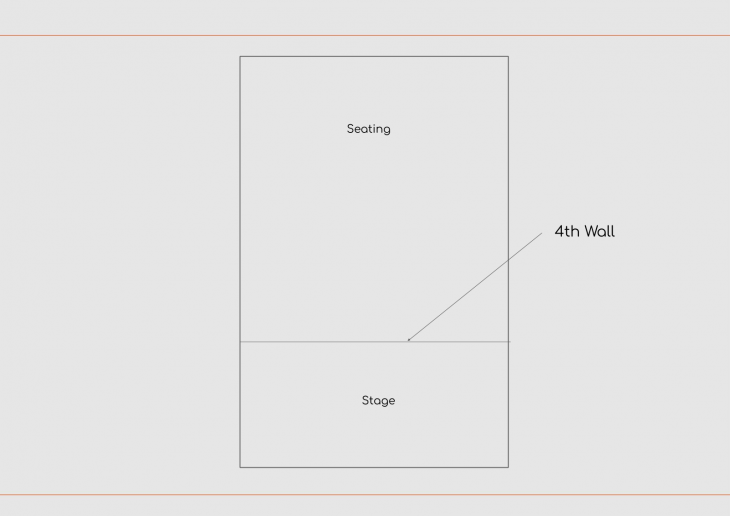
While the majority of the arts aim to show the audience a window of the imagination of the creator, the Fourth Wall rejects this notion, bringing the imagination of the creator out into the audience. This is typically exhibited when an actor breaks the illusion of a work of fiction, speaking directly to the audience from the voice of reality. It can be seen in many visual works of fiction, as well as in music, paintings or photography and for the purposes of this essay architecture. For example, in writing this essay, I could break the Fourth Wall by apologising to the reader for the length. The Fourth Wall is defined as:
“The imaginary barrier that separates the characters in a work of fiction from the people who are watching or reading the story they are in.”
(Oxford Dictionary, 2020, © 2020 Oxford University Press)
“The imaginary barrier of a play, television programme, or film separating the actors from the audience.”
(Collins American Dictionary, 2020, HarperCollins Publishers)
In the context of plays, to break the Fourth Wall the actors on stage must consciously talk to the audience, breaking the illusion that the audience is separated from the actors by an illusionary wall that is the boundary of the stage. This doesn’t include when audiences are making noise and an actor feels the need to shush them nor if someone falls off the stage as that was an accidental breaking of the Fourth Wall, as neither of these incidents is a predetermined breaking of the Fourth Wall., Additionally, it does not include when actors hide within audiences and are spoken to by actors on the stage, as in this circumstance the actor is still in character still is holding onto whatever is happening in the story and while they may touch or play with the audience or audience members they are holding the illusion of the story. For example, in The Lion King musical, some of the characters enter from the back of the audience, and the “animals’ will act with the audience holding on to the illusion that they are animals.
There is often some confusion between the concept of the Fourth Wall and a concept known as ‘Metafiction’. While the Fourth Wall reflects the breaking of the wall formed by created imagination entirely, Metafiction refers to the point in the arts when the characters in a play suggest that they know that they are in fact in a play, however, they continue as if the audience doesn’t exist, staying in character as the suspension of disbelief is held. “Six Characters in Search of an Author” is another work of clear metafiction where the cast acknowledge the audience as an audience but then the audience becomes part of the fiction, part of the illusion and the suspension of disbelief is upheld not only by the actors but also by the audience as part of the play.
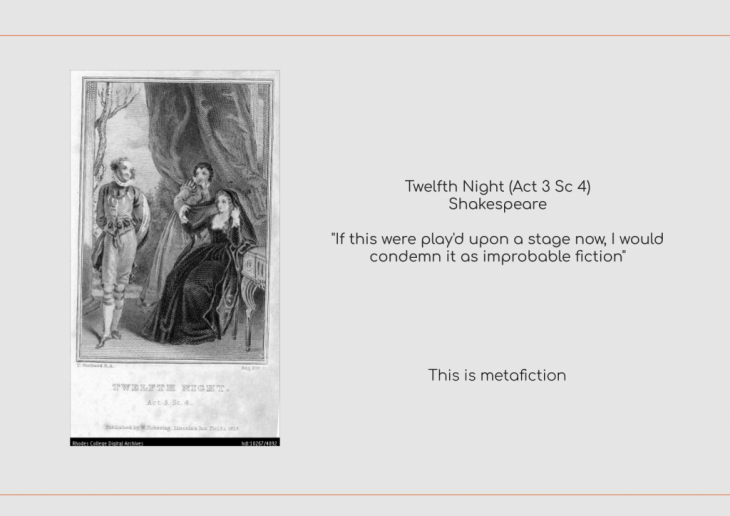
Twelfth Night (Act 3 Sc 4) Shakespeare
“If this were play’d upon a stage now, I would condemn it as improbable fiction”
THEATRE
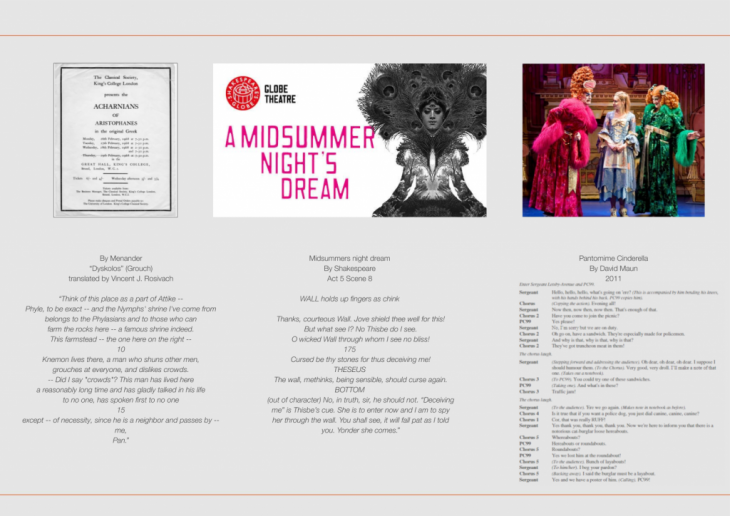
Looking through the timeline of this creative technique, up until the 17th century, there was no formal understanding of the Fourth Wall to break in the first place. Prior to this, the concept appeared in the guise of a couple of different tropes, the ancient Greeks called it the chorus and at the beginning of a play, the main character would not only set the scene they’d tell the audience who they were and what they were thinking. In the 17th century and within Shakespeare’s time, almost all monologues and certainly all soliloquies were seen to break the Fourth Wall. These are often used to lighten a situation or to tell the audience more about what they needed to know about the characters.
By Menander
“Dyskolos” (Grouch)
translated by Vincent J. Rosivach
“Think of this place as a part of Attike —
Phyle, to be exact — and the Nymphs’ shrine I’ve come from
belongs to the Phylasians and to those who can
farm the rocks here — a famous shrine indeed.
This farmstead — the one here on the right —
10
Knemon lives there, a man who shuns other men,
grouches at everyone, and dislikes crowds.
— Did I say “crowds”? This man has lived here
a reasonably long time and has gladly talked in his life
to no one, has spoken first to no one
15
except — of necessity, since he is a neighbor and passes by — me,
Pan.”
This is an instance of it being used to let the audience know where and who the play is about. Its set in “Attike, Phyle to be exact” the play is about “Knemon”, a man who shuns other men. And “me, Pan.” it tells the audience exactly who the actor is playing, he introduces the main character of the play, that is to say, the Grouch.
Midsummers night dream
By Shakespeare
Act 5 Scene 8
“I fear my Thisbe’s promise is forgot!—
And thou, O Wall, O sweet, O lovely Wall,
That stand’st between her father’s ground and mine.
170
Thou Wall, O Wall, O sweet and lovely Wall,
Show me thy chink to blink through with mine eyne!
WALL holds up fingers as chink
Thanks, courteous Wall. Jove shield thee well for this!
But what see I? No Thisbe do I see.
O wicked Wall through whom I see no bliss!
175
Cursed be thy stones for thus deceiving me!
THESEUS
The wall, methinks, being sensible, should curse again.
BOTTOM
(out of character) No, in truth, sir, he should not. “Deceiving me” is Thisbe’s cue. She is to enter now and I am to spy her through the wall. You shall see, it will fall pat as I told you. Yonder she comes.”
In this instance, the Wall is broken not only by the actor stating an aside but apparently to give his fellow actors direction. If this was not written by the playwright, this wouldn’t be a breaking of the Fourth Wall but as it is part of the play and used to progress the story, the suspension of disbelief is broken, the audience is reminded that these characters are actors and thus the Fourth Wall is broken.
However that changed in 1758 Denis Diderot said “When you write or act, think no more of the audience than if it had never existed. Imagine a huge wall across the front of the stage, separating you from the audience, and behave exactly as if the curtain had never risen.” in doing so changed the fashion of plays at the time, it was still used but to a much less extent and it wasn’t until the beginning of the cinema era we see it used to huge success again. It has become a more modern trait taking prominence with Epic Theatre, where it is a mixture of breaking the Fourth Wall and alienation for the characters that allowed it to become used in political arts.
OTHER EXAMPLES
The Fourth Wall is also used in almost every Pantomime performance. Within these children’s theatrics, the characters often ask the children in the audience for help, asking them to call out if they see the ‘bad guy’. In this instance, as the characters address the audience, they are breaking the Fourth Wall.
CONCLUSION OF THE DEFINITIONS
The definitions suggest that the breaking of the Fourth Wall is just a break of an illusion but within the context of a play there are seemingly many reasons to break the Fourth Wall. There is a reason to do it to give the audiences a deeper understanding of the characters inner thoughts or so that the audience can understand a situation better or with more nuances, or comedic relief, so break the tension created from the play. It should always be a though outbreak or a conscious break of the illusion that the actors cannot see the audience, or interact with the audience. And a break in the story that’s being wove for the audience.
BOOKS
Jane Eyre, by Charlotte Bronte,
“And dear reader, I married him”
This literature is a clear break in the Fourth Wall as not only does the author address us, she names us ‘reader’. She knows we are reading the book. In this instance, the character stays in her character of Jane.
The French Lieutenant’s Woman, by John Fowles
“This story I am telling is all imagination. These characters I create never existed outside my own mind. If I have pretended until now to know my characters’ mind and innermost thoughts”
This is an acknowledgement that the author wants to tell the reader an acknowledgement that the characters are all made up. The illusion is broken. You are forced to acknowledge that you are reading a story that has not happened in reality. Also when characters comment on bad jokes or bad writing or comment on the author
MUSIC
If the fourth wall is a break in an illusion, then within music it’s not necessarily during live music than it can be broken, as often there is no illusion, or if there is its lip singing and that illusion would upset people if it were broken, unless it’s used to comedic effect, as can be seen with a number of comedic musicians, eg Alex and the brass band, however, we can see it broken by music that is recorded.
“If you’re listening to this song
You may think the chords are going wrong
But they’re not
We just wrote it like that”
(Beatles. The Beatles. EMI Records, 1968. CD. “only a northern song”)
The musicians acknowledge that you’re listening to a recording, that this is not a live production. And that there are many people listening to this song that there are “listeners”.
“Farmer Refuted”, from Hamilton, by Lin Manuell Miranda, (2016)
“Don’t modulate the key then not debate with me.” (immediately following a key change)
The song is from the musical Hamilton so is an original version of Breaking the Fourth Wall. However, the illusion of the actors not realising they are in a musical is broken by a direct reference to the music they are singing.
“Are you Lonesome Tonight” by Elvis Presley Las Vegas (1969)
In this particular recording, halfway through the song, Elvis starts laughing, clearly, something happened during the recording that caused him to laugh however the illusion of the sombre song is completely broken by the real-life event that took place. This might not be seen as breaking the Fourth Wall but the artist used it as a recording, so it may have started as an accident but by publishing it with this acknowledges mistake it by definition breaks the fourth wall.
PHOTOGRAPHY AND PAINTING
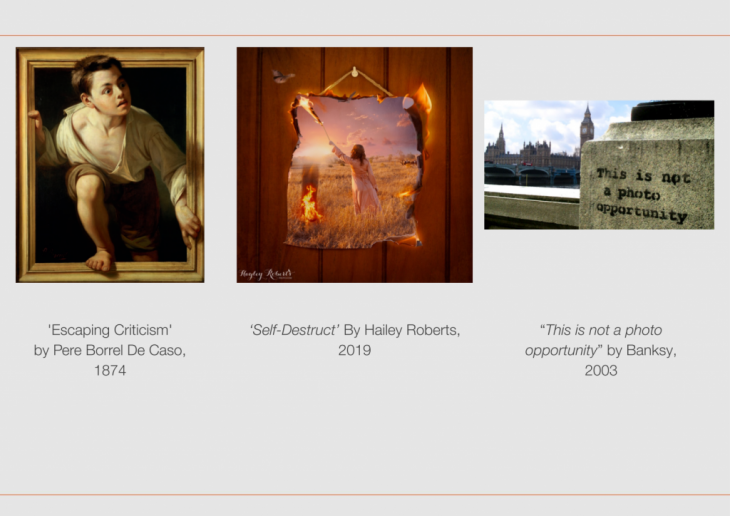
The Fourth Wall is easily broken in photography when people in a given photograph look directly into the camera. However, with the use of Photoshop and the introduction of creative compositions, there is a growing trend to break the Fourth Wall in more original ways.
‘Self-Destruct’ By Hailey Roberts, 2019
This has become a common form of art, photoshop images that are made from a series of composite photos. This has a number of breaks of the illusion, from the paradox of the girl in the picture setting fire from a bad angle to the photo that she exists in.
Just as the introduction of Photoshop initiated the potential for more creativity within photography, the ability to add originality and creativity to paintings, enables a more prominent breaking of the Fourth Wall. The figures must be painted looking directly at the viewer of the painting or in more creative examples, they literally escape the illusion they exist in.
‘Escaping Criticism’ by Pere Borrel De Caso, 1874
“This is not a photo opportunity” by Banksy, 2003
Graffiti has been used as another modern example of breaking the Fourth Wall. It calls attention to what photographers will often do in the spot where graffiti has been stencilled. In this instance, the graffiti breaks the illusion of art by recognising its main audience (people who take photos of it).
CINEMA
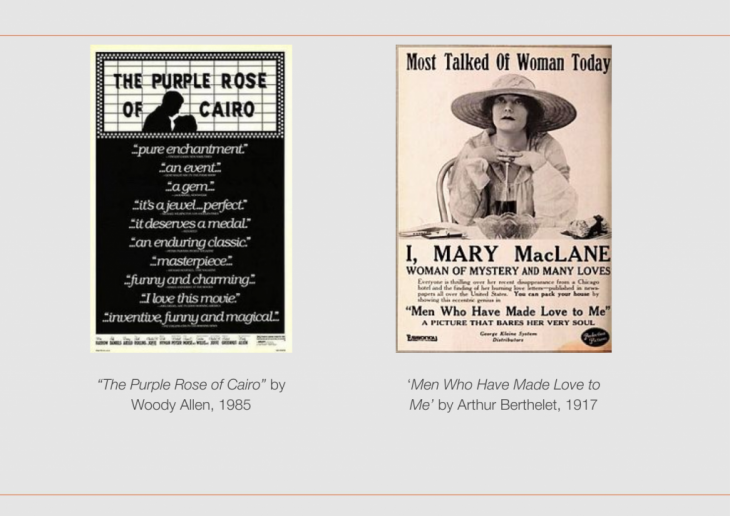
‘Men Who Have Made Love to Me’ by Arthur Berthelet, 1917
The first instance of film breaking of the Fourth Sall is Mary Mclane’s “Men Who Have Made Love To Me”. This is a silent black and white film based on the story of the author and self-played actress Mary McLane. Throughout the stories of five different men that date her, she stops the flow using cards to explain to the audience the troubles of the men.
“The Purple Rose of Cairo” by Woody Allen, 1985
This movie is all about breaking the Fourth Wall, however, it doesn’t actually break its own Fourth Wall. Many Woody Allen movies do, the most obvious example is “Annie Hall” (1977), in the case of ‘The Purple Rose of Cairo’, it is used for a comedic effect. It becomes a type of metafiction as the audience sits and watches a movie about a girl sitting and watching a movie, which results in the main character comes out of the screen to talk.
The concept of breaking the Fourth Wall has been in cinematography since it’s earliest days with the likes of Chaplain. Nowadays, we still see it used in many movies, becoming part of the many “easter eggs’ ‘ (hints or funny surprises) dropped into many movies. It’s also used very often on tv too, one of the more popular tv shows at the moment ‘Fleabag’ by Phoebe Walker-Brown uses it very often. This is not to say her character always speaks often it’s just a look directly at the screen, however, it’s developed further by characters within the program then asking who is she looking at or talking to. Thus we see an excellent example of characters breaking the wall that separates their own illusions of imagination, thus potentially going one step further to break the ‘Fifth Wall’.
It is also used in ‘House of Cards’, ‘Monty Python’ movies, a huge number of comics like ‘Deadpool’, and therefore the movies based on comic books. In graphic novels, it is comparable to examples of breaking the Fourth Wall in literature, as the artist recognises that there are readers listening in to a story and you will often see key characters directing attention towards the readers.
ARCHITECTURE
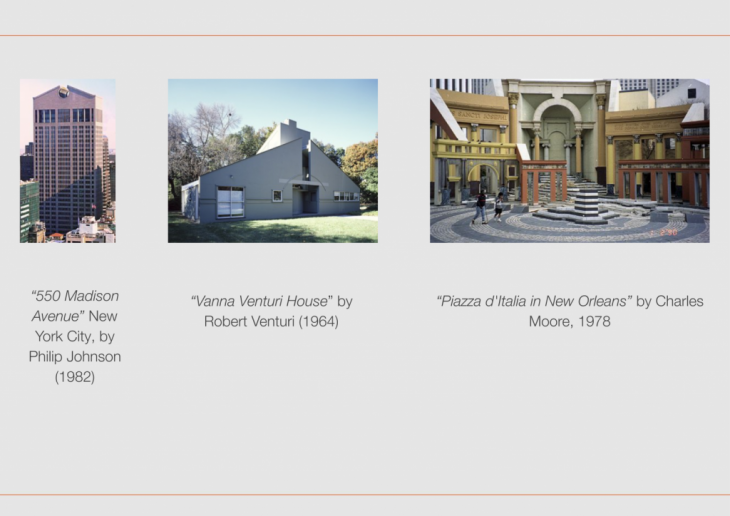
In architecture, we acknowledge the architect is playing a game with the users of the building, they are creating an illusion within the building. Therefore the Fourth Wall is broken when an architect intentionally breaks the illusion, in doing so they provide either more information about the building or a moment of comedy.
Illusions have always been a part of the architecture. This necessity comes from many things, from the inherent use of structural materials to a desire to seem more wealthy than you are, the amount of space or light within a space, to the complexity of the ‘language’ being used within a building. These things can be seen from the ancient greek period all the way through modern and advanced architecture.
I would argue that Postmodernism actually falls under Metafiction as opposed to breaking the Fourth Wall. None of these buildings breaks an illusion that they are or aim to create. However, each of them mildly mocks the historical contexts they sit in. they don’t impart more information to their audiences, nor do they break the illusion they’ve created.
Instead, it can be argued that Brutalism was one of the most obvious breakings of the Fourth Wall. As the theory of Brutalism was to let laypeople know the truth of the buildings. Due to this a lot of the methods of construction are laid bare for everyone to see and more importantly, to understand the illusion of construction. In a number of buildings, the windows were left as open so that people see or know what was happening within the buildings. This leads to a further rise in the breaking of the Fourth Wall not only in architecture but in what people do within a building as well. Brutalism breaks the Fourth Wall that is architecture, the mystery of design and how a building comes together.

In Peter Eisenman’s work, we can see Deconstructivism, and we can see how it breaks the Fourth Wall in the majority of the cases. The ideas of Deconstructivism are as the title suggests: a building deconstructed and a deconstructed building that gives us the illusion that the building is falling. But in every case, Eisenman has left obvious clues for the structure, be it through windows that have been clearly marked on the facade, which allows us to understand why the buildings won’t fall. Thus these buildings all break the fourth wall.
ADVANCED ARCHITECTURE
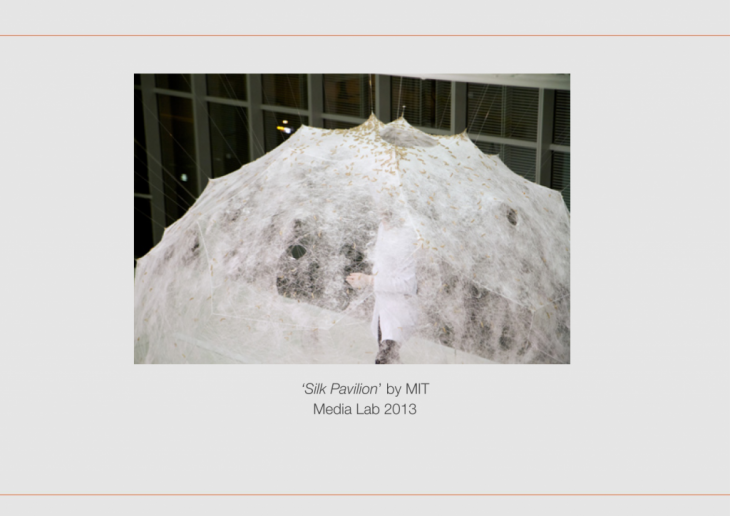
A robot creates a hoop inspired design by connecting varying threads. The threads are attached to the surrounding walls and ceiling in order to create the base structure of a dome. Live silkworms are then introduced to the structure and then use the threads formed by the robot to create a dome-like structure. This challenges the concept of the Fourth Wall, as the imaginative design aimed to be created by nature (ie the silkworms) is disrupted as the audience can see the threads constructed by technology (ie the robot), therefore breaking the Fourth Wall of design. This is inherently an example of breaking the Fourth Wall, however, the use of the Fourth Wall cannot be avoided in this instance as the dome would not be formed without the support of the robot-built threads. Additionally, this allows us greater insight into the finer workings of this structure and design.

The Yokohama International Passenger Terminal embodies an incredibly futuristic design, flowing into its backdrop of a picturesque harbour, creating an illusion that it is a part of the natural landscape itself. This illusion is then broken by the highly contrasting lower level, which seeks to provide structural support to the smooth landscape design. The lower level breaks the effect of any naturalness that the upper level seeks to create, thus breaking the Fourth Wall out of sheer opposition. The drama of the contrast makes both look better than had the illusion not been broken.
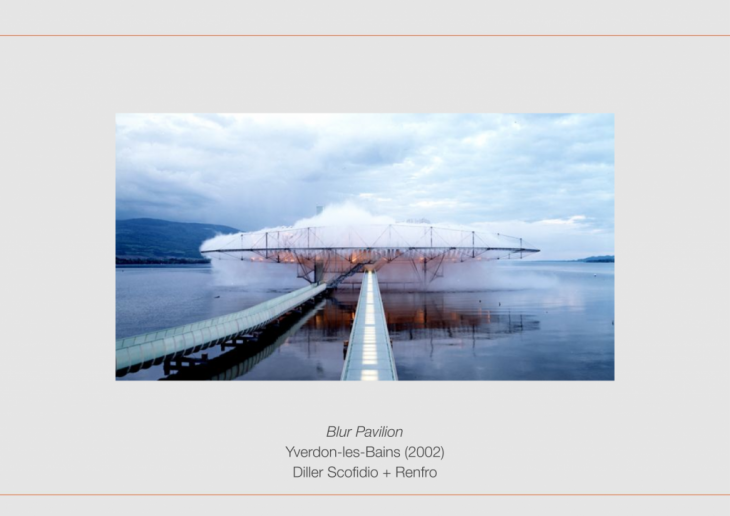
It’s hard to know where the illusion of the ‘Blur Pavilion’ stops or starts as the building itself blurs into the background. The architects wrote about the intended illusion created by this Blur Pavilion when referencing the sounds created by the pulsing nozzles: “Upon entering Blur, visual and acoustic references are erased. There is only an optical “white-out” and the “white-noise” of pulsing nozzles” (DS+R,2002). The acoustic references are erased, however, you can hear the building making the fog that you stand in, you can hear the fact that this is not a natural place of real fog and silence. However, on particularly windy days, the illusion is broken as the building becomes visible. As the architects would undoubtedly have been aware of this environmental impact, one could argue that this in itself is a breaking of the Fourth Wall.
CONCLUSION
To conclude this argument, we have analysed the history of the concept that is the Fourth Wall, watching as it unfolded throughout art and literature. It’s similarities yet differences to Metafiction were briefly discussed and examples of breaking the Fourth Wall were seen in movies, songs, literature and plays. We then turned this research to exploring the role of the Fourth Wall in Architecture. Within the architectural analysis, two clear conclusions were drawn: one of error and another of occurrence by default.
Within architecture, it is hard to decide which designs break the Fourth Wall on purpose versus what breaks it accidentally. This leads to further questioning as to what is on purpose versus what is a symptom of poor design decisions or poor planning. Honestly, I think it can be a bit of both and it depends on what illusion has been generated, as the more complex the illusion the easier it is to break. Examples such as Eisenman’s Buildings that look as if they are on the verge of collapse, which offers a much more complex illusion and thus is a more blatant example of the breaking of the Fourth Wall than the example of the Silk Pavilion.
I would also argue that almost all cases of design contrasts break the Fourth Wall. When a decision is made to contrast one illusion with another, it almost automatically means that one illusion will be proved as a fallacy, therefore can’t help but break the Fourth Wall, ie the illusion created is disrupted by it’s own comparison to the opposing design. Examples of this include the Yokohama International Passenger Terminal by FOA, but most buildings that have extreme contrasts will do this.
Fourth wall is a project developed at IaaC, Institute for Advanced Architecture of Catalonia, developed at Master in Advanced Architecture 2019/20
by: Student: Holly Victoria Carton
Faculty: Manuel Gausa, and Jordi Vivaldi